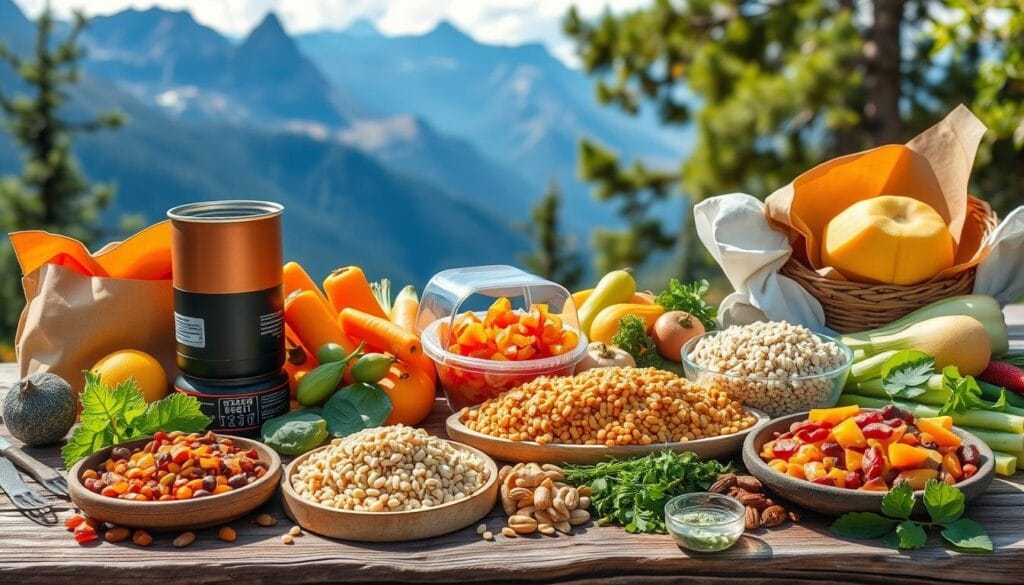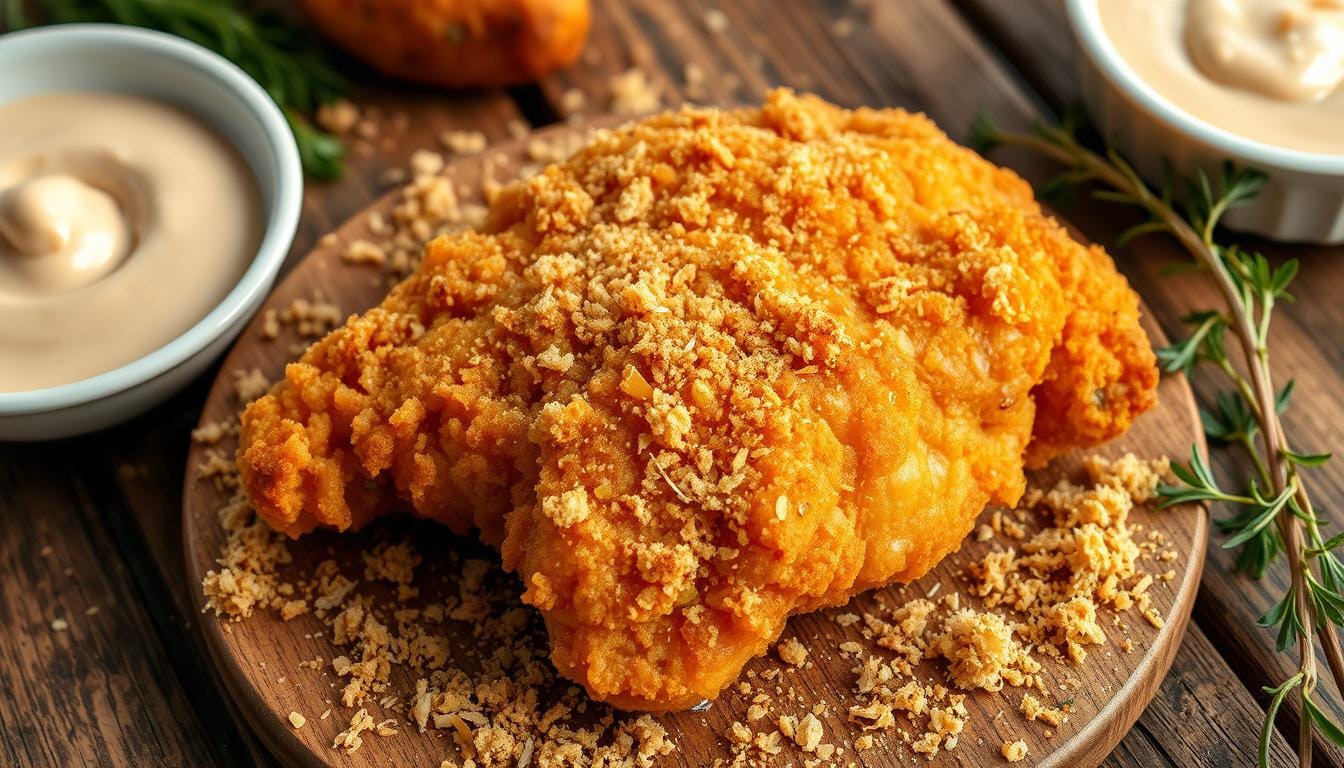Are you getting ready for your next backpacking trip? Thinking about how to fuel your body is key. We’ve got a guide for easy camping meals and outdoor cooking ideas. Perfect for all backpackers, we’ll show you simple and tasty options to keep you going.
Homemade hike bars offer 250 to over 400 kcal per piece, giving you lots of energy. Making your own can save money, costing just $2 to $4 each. They’re quick to make, taking 10 to 15 minutes. Plus, you can try easy meals like instant noodles and freeze-dried yogurt parfait for variety.
Key Takeaways
- Backpacking recipes can be easy to make and provide substantial energy for outdoor activities
- Homemade hike bars can be a cost-effective and easy solution for backpackers
- Easy camping meals like instant noodles and freeze-dried yogurt parfait can add variety to your backpacking recipes
- Backpacking recipes should include a balance of carbohydrates, protein, and fats to combat meal fatigue
- Lightweight trail food and outdoor cooking ideas can help minimize waste and make meal planning easier
- Backpacking recipes can be tailored to individual dietary preferences and needs
Essential Guidelines for Backpacking Food Preparation
Having the right food is key for backpacking. It keeps you energized on your adventure. Proper food prep and storage are vital for a safe, healthy trip. Remember, food safety is a must to avoid risks.
Knowing your nutritional needs is important. This includes your daily calorie intake, which varies based on activity and individual needs. Drinking water and eating foods or supplements with electrolytes is also key.
Some key considerations for backpacking food prep include:
- Plan your meals ahead to get the right nutrients.
- Use proper food storage to keep it fresh and safe.
- Bring the right cooking gear, like a portable stove or camping grill.
By following these tips and focusing on food safety, you can have a great backpacking trip. Always put your health and safety first. If you have questions, ask experienced backpackers or outdoor experts.
With the right knowledge and prep, you can make tasty, nutritious meals on the trail. Enjoy your outdoor adventure to the fullest.
| Food Type | Caloric Intake |
|---|---|
| Breakfast | 50-220 calories |
| Lunch | 70-220 calories |
| Dinner | 371-920 calories |
Planning Your Backpacking Meals
When backpacking, meal planning is key to keep your energy up. With over three decades of experience, planning quick backpacking meals is essential. A good meal plan helps avoid a big calorie drop, which is important on short trips.
Start by thinking about what you like to eat and what you need. Make a list of quick backpacking meals that are full of calories and nutrients. Instant noodles, freeze-dried yogurt parfait, and DIY dehydrated meals are great options. Here are some tips to help you plan:
- Plan your meals based on your trip schedule and how many days you’ll be hiking.
- Choose foods that are light but full of calories to keep you energized.
- Remember to pack snacks to keep your energy up all day.
By using these tips and planning your meals, you’ll have the energy and nutrients you need for your hike. Always pick quick backpacking meals that are easy to make and won’t slow you down.
| Meal | Calories | Protein | Fat | Carbohydrates |
|---|---|---|---|---|
| Breakfast sample | 878.82 | 71.1g | 54.28g | 96.3g |
| Dinner example | 994.02 | 35.13g | 38.44g | 118.34g |
Best Backpacking Recipes for Breakfast
Breakfast is key when backpacking. It gives you energy and nutrients for hiking. There are many tasty breakfast ideas for the trail.
Try instant oatmeal with dried fruits and nuts for a quick breakfast. It’s ready in minutes and gives you energy. Another choice is a protein-packed breakfast scramble with dehydrated eggs and sausage. It’s tasty and keeps you going all day.
No-cook breakfasts are also great. You can have cold options like Pop-Tarts or bars. Or, choose something healthier like cereal with powdered milk. Smoothies and meal-replacement shakes are also good for quick nutrition.
| Breakfast Option | Preparation Time | Nutritional Value |
|---|---|---|
| Instant Oatmeal | 5 minutes | High in fiber and carbohydrates |
| Protein-Packed Breakfast Scramble | 10 minutes | High in protein and calories |
| No-Cook Morning Options | 0 minutes | Varies depending on option |
These are just a few breakfast ideas for backpackers. Choosing a tasty and nutritious breakfast makes your day on the trail better.
Trail-Ready Snacks and Energy Boosters
When you start a hike, it’s key to bring lightweight trail food for a quick energy boost. You might burn thousands of calories on a hike, depending on the trail’s difficulty and how long it is. To get your energy back, pack snacks like energy bars, trail mix, and dried fruits.
Here are some energy boosters you can try:
- Homemade hike bars with nuts and dried fruits
- Trail mix with nuts, seeds, and dried fruits
- Energy bars with caffeine and electrolytes
Choose snacks that are lightweight, nutritious, and easy to carry. With the right lightweight trail food and energy boosters, you’ll stay energized on your hike.
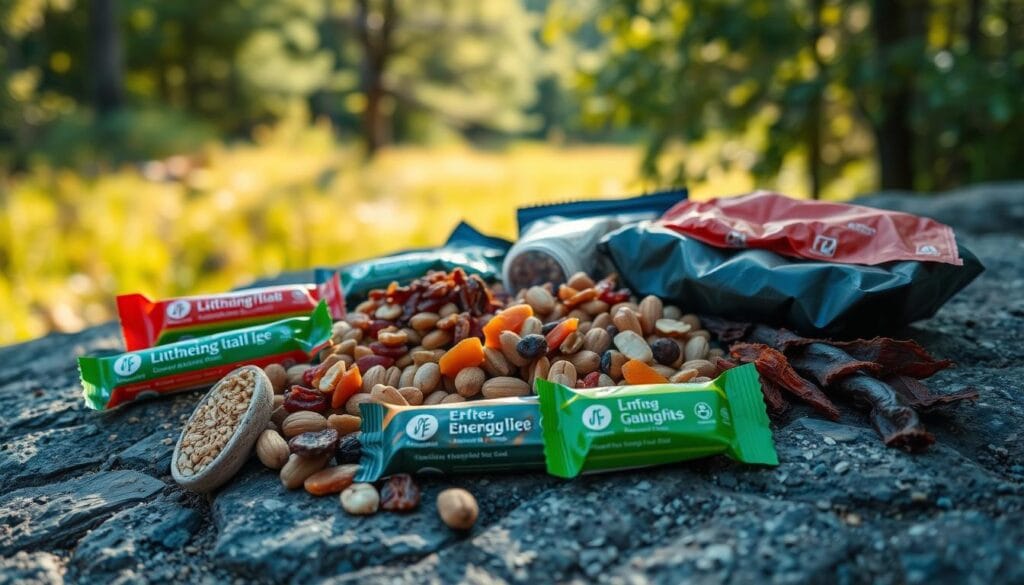
Lightweight Lunch Ideas for Hikers
Lunch is key for hikers to refuel and get ready for more hiking. A light lunch helps you hike further without feeling heavy. It’s all about finding the right balance.
Wraps, flatbreads, cold-soak recipes, and quick trail lunches are great. They’re easy to make and give you the energy you need. Plus, they’re light, so you can move freely.
Try a cold-soak lunch with instant noodles, veggies, and tuna or chicken. It’s quick, nutritious, and won’t weigh you down.
For something even quicker, mix crackers, cheese, and meats. You can make it your own, fitting your taste and needs.
Here are more ideas for light lunches:
- Dehydrated salads with couscous or beans
- Smoothies with oatmeal and other good stuff
- Wraps with hummus, veggies, and lean meats
Adding these meals to your hiking plan keeps you energized and focused. Always keep your food safe and enjoy the hike.
Hydration and Electrolyte Drinks
Staying hydrated is key for backpackers, more so in hot or high places. Electrolyte drinks keep the right balance of minerals like sodium and potassium. It’s good to drink 1 liter of water for every 5 miles.
Dehydration can cause headaches, tiredness, and feeling dizzy. To stay hydrated, drink electrolyte-rich drinks that have sodium and potassium. Lemons, oranges, and 100-percent fruit juice are good sources.
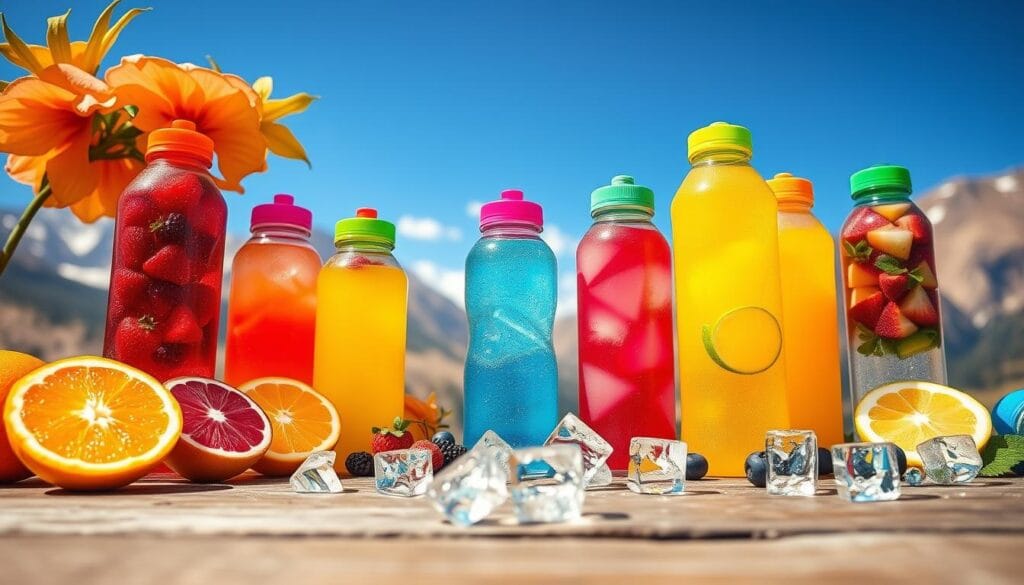
You can make your own electrolyte drink. Mix water with salt, lemons, and honey. For a half-gallon, use 40-50 grams of sugar, or 10-12 teaspoons.
Here’s how to make a homemade electrolyte drink:
- Use salt, lemons, and honey for a balanced drink.
- Adjust sugar to taste, aiming for 10-12 teaspoons per half-gallon.
- Add coconut water or fruit juice for extra electrolytes.
| Ingredient | Amount |
|---|---|
| Salt | 1/4 teaspoon |
| Lemons | 1/2 lemon, juiced |
| Honey | 2-3 tablespoons |
One-Pot Dinner Solutions
Dinner ideas for backpacking should be simple and easy to make. Simple camping recipes can be a big help, giving you a tasty meal after hiking. One-pot meals are perfect because they need fewer ingredients and are easy to clean up. For instance, try a one-pot backpacking meal that mixes proteins, veggies, and grains in one pot.
Popular one-pot meals include dehydrated recipes, meals with fresh ingredients, and vegetarian options. You can use beef, chicken, or plant-based proteins. They can be cooked over a campfire or on a portable stove. For ideas, look at quick and easy recipes that work for backpacking.
Here are some benefits of one-pot meals:
- Reduced cleanup time
- Less ingredients needed
- Easy to prepare
- Delicious and satisfying meals
One-pot meals are a great choice for backpackers. They offer tasty meals without the trouble of complex prep and cleanup. By using simple recipes and one-pot ideas, you can enjoy many dinner options while backpacking.
| Recipe | Ingredients | Cooking Time |
|---|---|---|
| Savory Campfire Stew | Beef, vegetables, grains | 45 minutes |
| Zesty Campfire Mexican Quinoa | Quinoa, chicken, vegetables | 20 minutes |
| Classic Campfire Jambalaya | Rice, chicken, sausage | 20 minutes |
No-Cook Backpacking Recipes
When backpacking, no-cook meals are a big help. They’re simple to make, need little gear, and taste great. For backpackers, backpacking recipes that don’t need cooking are perfect. Trail mix, energy bars, and salads are favorites.
Here are some ideas for no-cook meals and snacks:
- Trail mix with nuts, seeds, and dried fruits
- Energy bars made with wholesome ingredients
- Salads in a jar with mixed greens, vegetables, and lean proteins
- Avocado tuna salad with whole grain crackers
- Greek pita bento box with hummus, cucumber, and tomato
No-cook backpacking recipes are ideal for those who want to save time and effort. With a bit of creativity, you can make tasty, healthy meals without cooking. Whether you need a quick snack or a full meal, no-cook recipes are a smart choice.
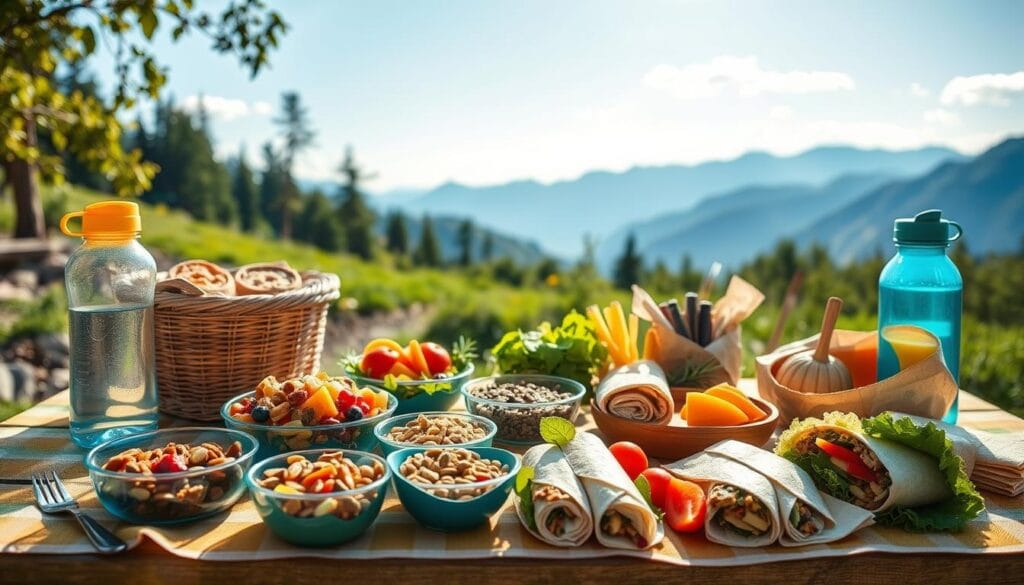
| Recipe | Prep Time | Calories per Serving |
|---|---|---|
| Avocado Tuna Salad | 10 minutes | 786 kcal |
| Greek Pita Bento Box | under 20 minutes | varies |
| Trail Mix | no prep time | varies |
Food Storage and Preservation Methods
For backpackers, keeping food safe is key, even more so in bear country. Use airtight containers and keep them away from your campsite. Methods like dehydration and freeze-drying can also help your food last longer.
Dehydration cuts down food moisture to 10-20%, stopping bacteria and mold. Foods are dried at 95°F to 160°F (35°C to 71°C). The best drying temperatures vary by food type.
- Fruits: 135°F to 140°F (57°C to 60°C)
- Vegetables: 125°F to 135°F (52°C to 57°C)
- Meat (jerky): 145°F to 160°F (63°C to 71°C)
Freeze-drying is another good way to preserve food. It takes 20 to 40 hours and freezes food to -30 to -50 degrees Fahrenheit. These methods help ensure a safe, healthy trip.
Choosing the right containers for food is important. Silica gel packs can keep food dry, weighing just 2g each. Dehydrators like the Excalibur and BioChef are great for drying food. The BioChef even has a timer for easier use.
| Food Type | Dehydration Temperature | Freeze-Drying Time |
|---|---|---|
| Fruits | 135°F to 140°F (57°C to 60°C) | 20 to 40 hours |
| Vegetables | 125°F to 135°F (52°C to 57°C) | 20 to 40 hours |
| Meat (jerky) | 145°F to 160°F (63°C to 71°C) | 20 to 40 hours |
Weight Management Strategies for Food Packing
When backpacking, weight management is key. You need enough energy for your hike but don’t want to carry too much. Opt for lightweight trail food that’s packed with calories and nutrients. Freeze-dried meals and instant noodles are great because they’re light and simple to make.
Here are some tips for managing weight and picking the right food for your trip:
- Choose calorie-dense foods that are high in nutrients and low in weight
- Consider the weight and bulk of your food when packing
- Plan your meals in advance to ensure you have enough energy for your hike
By following these tips and choosing the right lightweight trail food, you can manage your weight and have a successful trip. Always focus on weight management and pick foods that are calorie-rich and nutritious.
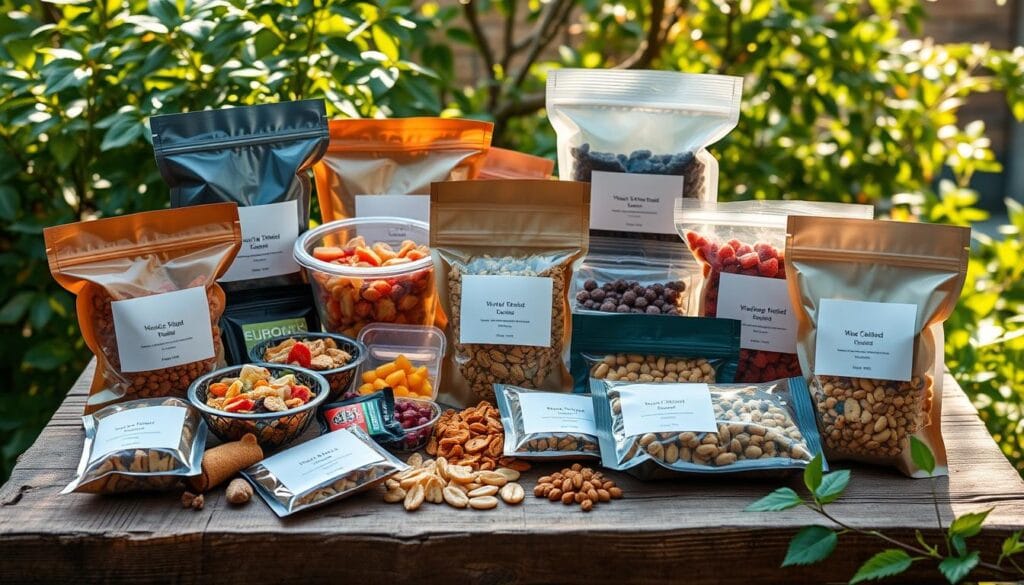
| Food Type | Weight | Calories |
|---|---|---|
| Freeze-dried meal | 3 oz | 300 calories |
| Instant noodles | 2 oz | 200 calories |
| Trail mix | 4 oz | 400 calories |
Seasonal Recipe Adaptations
Planning your backpacking trips means thinking about the right food. You want meals that are tasty and good for you. We’ll look at recipes for summer and cold weather.
Summer Hiking Meals
Summer calls for light and cool meals. These keep you energized and comfortable. Here are some ideas:
- Trail salads with fresh fruits and nuts
- Grilled chicken or fish with roasted vegetables
- Chilled soups with crusty bread
Cold Weather Food Solutions
Cold weather needs warm and hearty meals. These keep you cozy and full. Here are some options:
| Meal | Ingredients | Preparation Time |
|---|---|---|
| Beef Stew | Beef, vegetables, broth | 30 minutes |
| Chicken and Rice Bowl | Chicken, rice, vegetables | 20 minutes |
| Lentil Soup | Lentils, vegetables, broth | 25 minutes |
Seasonal recipes make backpacking meals exciting. They offer different tastes and textures. Always follow food safety and pack out trash.
Special Dietary Considerations
When planning backpacking meals, it’s key to think about special diets. These diets include vegetarian, gluten-free, and others. They need careful planning for a balanced and nutritious meal.
Backpackers with special diets must research and prepare their meals. They can make DIY dehydrated meals, energy bars, and other easy-to-pack options. Brands like these offer special diets meals, like gluten-free or vegetarian, for backpacking.
Here are some tips for planning special diets backpacking meals:
- Research and prepare DIY dehydrated meals that cater to specific dietary needs
- Choose energy bars and other convenient options that meet dietary requirements
- Consider consulting with a nutritionist or registered dietitian to create a personalized meal plan
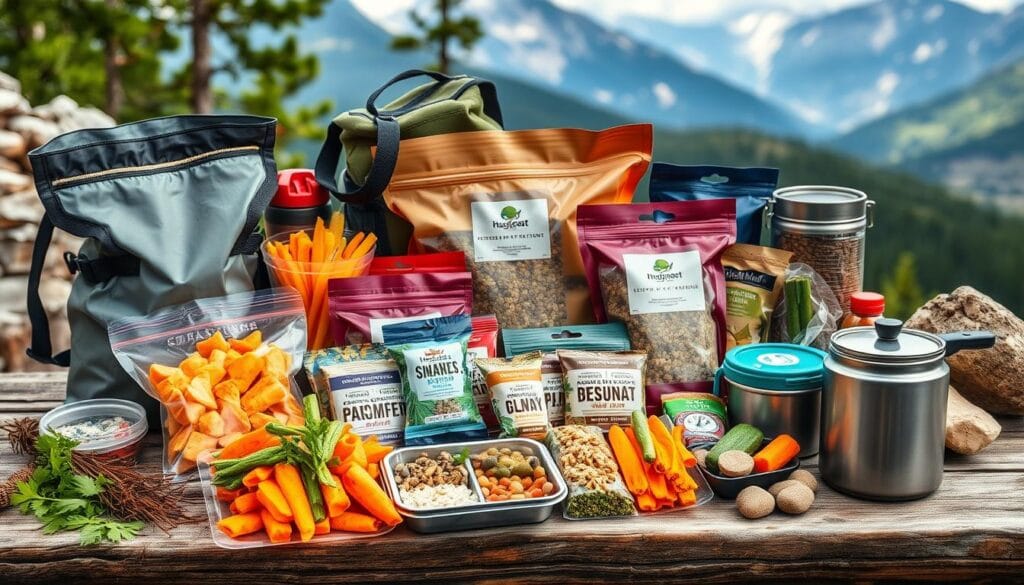
By considering special diets and planning backpacking meals right, backpackers can have a safe and fun trip. They’ll meet their dietary needs.
| Dietary Need | Backpacking Meal Option |
|---|---|
| Vegetarian | DIY dehydrated meals, energy bars |
| Gluten-free | Gluten-free energy bars, DIY dehydrated meals |
Emergency Food Planning
When planning a backpacking trip, think about emergency food. This is key for unexpected weather or getting lost. Having emergency food ensures your safety and well-being.
Choose non-perishable, high-calorie, and nutrient-rich foods. Energy bars, dried fruits, and nuts are great. They’re light, easy to make, and boost energy quickly.
Plan your food for the trip’s length. Aim for 1.5 to 2 pounds of food per person daily. This keeps you energized and ready for any delays.
Also, mix up your food to avoid boredom. Try freeze-dried meals, canned goods, dried meats, and instant soups.
- Freeze-dried meals
- Canned goods
- Dried meats
- Instant soups
Good planning ensures a safe, fun trip. Always check the weather and trail before you go. Be ready for any surprises.
Common Food Preparation Mistakes to Avoid
When you start your backpacking journey, knowing common food preparation mistakes is key. These mistakes can harm your health and safety. It’s important to handle and prepare food right to avoid getting sick.
One big mistake is not storing food well. This can attract animals and cause trouble. To avoid this, follow backpacking tips for food handling. Store food in tight containers and keep it away from campsites. Also, throw away trash correctly.
It’s also important to drink safe water. Make sure to use a filter to keep waterborne illnesses away.
- Insufficient food planning, leading to inadequate nutrition and energy
- Improper food handling and storage, increasing the risk of foodborne illnesses
- Not following proper cooking techniques, resulting in undercooked or overcooked meals
Knowing these common food preparation mistakes and following backpacking tips can make your trip better. Always focus on handling and preparing food safely. This keeps you healthy and happy on the trail.
Conclusion: Elevating Your Trail Cooking Experience
As you start your next backpacking trip, remember that backpacking recipes and trail cooking can be fun and rewarding. Plan ahead, pack the right stuff, and try out tasty meals. This will make your outdoor cooking better.
Try one-pot dinners, dehydrated meals, and use things like tortillas, rice, and canned beans. They make cooking easier and clean up less. Get portable, light stoves and cooking tools to make meals quicker. Also, think about flavor, nutrition, and what you like to eat to keep your energy up.
This guide is full of tips to make your trail meals better. Whether you’re experienced or new to outdoor cooking, you’ve got a lot to learn. Try new recipes, pack food better, and enjoy eating well in nature. Happy trails and happy cooking!
FAQ
What are the essential guidelines for backpacking food preparation?
How should I plan my backpacking meals?
What are the best backpacking recipes for breakfast?
What are some trail-ready snacks and energy boosters?
What are some lightweight lunch ideas for hikers?
How can I stay hydrated on the trail?
What are some one-pot dinner solutions for backpacking?
What are some no-cook backpacking recipes?
How should I properly store and preserve food while backpacking?
How can I manage the weight of my backpacking food?
How can I adapt my backpacking recipes for different seasons?
How can I accommodate special dietary considerations while backpacking?
How should I plan for emergency food situations while backpacking?
What are some common food preparation mistakes to avoid while backpacking?
Source Links
- 20 Insanely Easy And Tasty Hike Bars Recipes To Power Your Next Adventure 2025 – https://trailmaiden.com/easy-hike-bars-recipes/
- 15 Quick and Easy Backpacking Food Ideas for All Ages – Hailey Outside – https://haileyoutside.com/15-quick-and-easy-backpacking-food-ideas-for-all-ages/
- Easy Backpacking Meals Plan & Food Ideas For Your Trip – https://www.everester.org/backpacking-meals-plan-and-food-ideas/
- Meal Planning for Your Next Backpacking Trip – https://www.plantoeat.com/blog/2024/08/backpacking-food-ideas-and-tips/
- Complete Backpacking Food List and Meal Plan for the John Muir Trail — Backhacker Babe – https://www.backhackerbabe.com/johnmuirtrail/complete-backpacking-food-list-and-meal-plan
- How to Plan Food for a Backpacking Trip – The Big Outside – https://thebigoutside.com/how-to-plan-food-for-a-backpacking-trip/
- Get There From Anywhere – https://www.gettherefromanywhere.com/articles/how-to-plan-a-backpacking-menu
- Ultralight Backpacking Recipes – Homemade Just-Add-Water Meals – https://www.roadtripaddict.com/backpacking-recipes/
- Don’t Cook Breakfast In Camp. Try This Instead. – https://www.backpacker.com/skills/cooking/no-cook-camping-breakfast-ideas/
- Healthy Food for Hiking that Will Boost Your Energy on Trail – https://www.cinderstravels.com/food-for-hiking/
- The Power of Protein and Healthy Fats in Backpacking Meals – https://backcountryfoodie.com/power-of-protein-and-healthy-fats-in-backpacking-meals/
- Top Trail-Ready Meals and Snacks for Your Hiking Adventure – https://adventureco.com.au/blogs/news/trail-ready-meals-snacks-hiking-adventure?srsltid=AfmBOortujshgyPxB-0SifJ8zCuQAOP5fFbyWY0uFxoJ7iI6KFUDcoo9
- Lightweight Backpacking Lunches — Slower Hiking – https://slowerhiking.com/food/lightweight-backpacking-lunches
- Ultralight Backpacking Food | Meals for the JMT – https://getgooutdoors.com/ultralight-backpacking-food-list/
- DIY This Electrolyte Drink Before Your Next Hike – https://www.backpacker.com/recipes/electrolyte-drink/
- Homemade Electrolyte Drink Recipe: Natural Hydration For Athletes – https://www.kitchenstewardship.com/homemade-electrolyte-sports-drink-honey-stevia-sweetened/
- One-Pot Campfire Dinners – https://medium.com/@campingfiend/one-pot-campfire-dinners-2634fccefb84
- Boondocking Meals: Stovetop Stuffing and Chicken I Trail Cooking – https://trailcooking.com/2024/02/21/boondocking-meals-stovetop-stuffing-and-chicken/
- Recipes Archives – https://www.backpacker.com/skills/cooking/recipes/
- 40 Easy No-Cook Lunch Ideas for Backpacking or Hiking – The Hearty Life – https://theheartylife.org/40-easy-no-cook-lunch-ideas-for-backpacking-or-hiking/
- Buffalo Pasta Salad | Cold Soak Backpacking Lunch Recipe – https://backcountryfoodie.com/buffalo-pasta-salad-backpacking-lunch-recipe/
- Homemade Dehydrated Backpacking Meals: A No Nonsense Guide – Eat Sleep Wild – https://eatsleepwild.com/homemade-dehydrated-backpacking-meals/
- How to Make Your Own Freeze-Dried Backpacking Food Using Thanksgiving Leftovers – The Hungry Hiker – https://www.the-hungry-hiker.com/2024/12/03/how-to-make-your-own-freeze-dried-backpacking-food-using-thanksgiving-leftovers/
- Camp Cooking 101 — ERIC HANSON . TV – https://www.erichanson.tv/blog/camp-cooking-101
- Nutrition Strategy for Optimal Performance During a Thru-Hike – The Trek – https://thetrek.co/pacific-crest-trail/nutrition-strategy-for-optimal-performance-during-a-thru-hike/
- Balancing Nutrition, Hydration, and Weight in Bikepacking Food: A Comprehensive Guide – https://nextadventure.net/blogs/blog/balancing-nutrition-hydration-and-weight-in-bikepacking-food-a-comprehensive-guide?srsltid=AfmBOoraabEVR1YfPJSmYvMoOlyMpswunzinNyu6B-NUJgGMO3MvhR7F
- Tortellini Soup, Karissa Chen’s “Homeseeking,” and Ilulissat, Greenland – https://www.theskimm.com/newsletter/daily-skimm/tortellini-soup-homeseeking-ilulissat-greenland
- Tatsoi, bok choy’s tiny cousin – edible Southeastern Massachusetts – https://ediblesema.com/recipes/tatsoi/
- Like You, Restaurants Want to Live Like in the Movies – https://www.pdxmonthly.com/eat-and-drink/2024/08/tv-show-movie-theme-dinner
- Backpacking Food Meal Planning Tips – https://outdoorherbivore.com/meal-planning-eating-well/?srsltid=AfmBOorjOhhFBhxdlvZkPRcsDsiDGfCuaZE_NZBA3UOrgWkpaIUfx2RM
- 9 Backpacking and Camping Food Considerations | The Camping Food Guide – https://www.cruaoutdoors.com/blogs/blog/backpacking-and-camping-food-considerations
- 63 Backpacking Food Ideas – https://www.freshoffthegrid.com/backpacking-food-ideas/
- Pack Just the Right Amount of Backpacking Food with This Clever Tool – https://www.backpacker.com/skills/beginner-skills/backpacking-food-basics/backpacking-meal-planning-easy-clever-tool/
- Top Backpacking Food Ideas for Your Next Adventure – neo-travel-b2c-usa – AXA Partners – https://www.axatravelinsurance.com/top-backpacking-food-ideas-for-your-next-adventure
- Cooking Archives – https://www.backpacker.com/skills/cooking/
- The 52 Biggest Hiking Mistakes and How to Avoid Them – https://www.backpacker.com/skills/cooking/the-wrong-way-top-52-hiker-mistakes/
- Camping Food Hacks for an Unforgettable Outdoor Adventure | KAMUI – https://kamui.co/camping-food-hacks/?srsltid=AfmBOor02q9WcawQoZWZkzK_g_A5L1fcEVc_Rd4lrQW33wWiJAwQVydB
- Firepot Dehydrated Meals for Backpacking – https://takeoutdoors.com/camping-gear/cooking/firepot-dehydrated-meals-for-backpacking/

